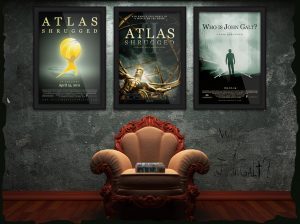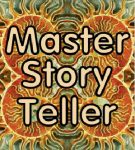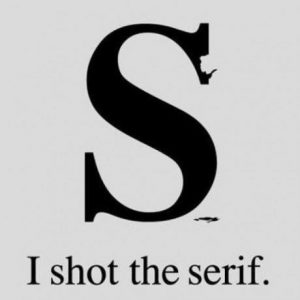I always wanted to invent LITTLE LORD ROYAL FONT
Author Archives: Melanie Anne Phillips
Atlas Shrugged – Why Did The Films Fail?
 Recently, I was commissioned to determine why the film adaptation of Ayn Rand’s book, Atlas Shrugged, had failed so miserably. Reading the 1200 page book and watching the six-hour movie trilogy resulted in a 36 page report, which my client has generously allowed me to share with you…
Recently, I was commissioned to determine why the film adaptation of Ayn Rand’s book, Atlas Shrugged, had failed so miserably. Reading the 1200 page book and watching the six-hour movie trilogy resulted in a 36 page report, which my client has generously allowed me to share with you…
http://storymind.com/content/page608.htm
Writing a Saul to Paul Story
A writer recently asked:
I am writing a Saul-to-Paul story whereby my protagonist begins the story with one goal in mind (i.e., persecution of a particular people on behalf of a dictator), but at some point through the story, he is persuaded to switch sides and overthrow the dictator.
Should my storyform reflect my protagonist’s initial goal or his later goal?
My reply:
It is important to separate the Main Character’s journey of growth from the protagonist’s journey to achieve a goal, even if a single character is both Main Character and Protagonist.
What changes in a Saul to Paul story is the Main Character’s attitude as to what is right and what is wrong.
In this case, the goal might be to do what is right, and his idea of “right” is what changes, but his goal to do “right” does not.
Melanie
Storymind.com
Back to Work, Writers!
BACK TO WORK, WRITERS!
Yes, writing is work. Though sometimes in the thrill of inspiration the process can be an amusement park of experiences, more often it is frustration, drudgery and stress. Over the years I’ve found that most of my clients for story consultation are looking for a silver bullet – some sort of creative elixir that throws open the floodgates of inspiration so that ideas just spill out all over their stories. And when they discover that while I can provide techniques to get their Muse in gear and insights to keep them on a good story development course, they are disappointed – no, perhaps “deflated” is a better word. Getting them over that hump and down to the serious business of writing is always the first priority. Quite honestly, some of them can’t make that climb – the hill is just too high. So, they turn away from that path and instead spend hundreds and often thousand of dollars on every patent medicine every snake oil story guru has to offer. Now to be sure, most teachers of story aren’t charlatans. And most aren’t gurus either. Rather, each has found some small “t” truth that works for them and they offer it up to any others it might help. But one size never fits all, so whatever one is hawking, there’s only a percentage of the flock who need your particular brand of wool curler. There is a big “T” truth out there to be sure, but as zen would have it, the tao that can be spoken is not the Eternal Tao – meaning that you can’t have your cake and eat it too. In other words, either it is teachable or it is Truth. So as you go back to work, you writers, you, consider that there is no single source for enlightenment, no special knowledge that turns work into play, and no silver bullet that severs the ties that bind better than a healthy amount of mental elbow grease to ease the friction of untying the damn thing.
Melanie Anne Phillips
Storymind.com
How to Grow a Sentence into a Story

Start with any sentence in your text, be it back story, something about your character or plot or even the outline of a scene.
Example: The dog ran over the hedge.
Now, ask as many intelligent, relevant questions about that sentence as you can (within reason).
Example: What kind of dog? How old is the dog? Does the dog have any physical deformities? What color is the dog? Does the dog have fleas? Does the dog have a collar? How fast was the dog running? Where did we first see the dog? Was it running then, or did it start? Why was the dog running (did it see something)? Was it running at something or away from something or just running? Was it running in a straight line? Did it have to jump to get over the hedge? How far above the hedge was it? Was it more like running through the hedge, than over it? What kind of plant is the hedge? How tall it is? How thick is it? Does the hedge look healthy and well-watered? Is the hedge trimmed and neat or unruly? What is the shape of the hedge? How wide is the hedge from side to side? Where is the hedge – a yard, an open field, between two walls in the inner city? Is the hedge on private property, and if so, what kind? Is the hedge flowering? Are there any bugs in or around the hedge? Is there anything hiding in the hedge? Are there any other dogs running? Are there any other animals or people present? How long does the dog run for? What happens when he stops?
Okay, you get the idea. By actually writing down these questions, rather than just trying to hold them in my head, I can now go back to each one and consider it separately, as one more potential piece of information to add to my original text.
Now if I have the answer right up front, already devised, or if it just comes to me as soon as I ask the question, then I can just add that answer right into to my text.
Example: What kind of dog? A Sheltie. Revised original sentence, “The Sheltie ran over the hedge.”
Now, a different vision comes to mind when the sentence is read and it alters the reader experience as well as enriching the story-in-progress.
But, if you don’t have an answer in mind, then let your Muse run wild and come up with a bunch of different answers, again within reason, so that you can then pick among the options for the most interesting choice.
Example: What kind of dog? Sheltie, Beagle, Bull Dog, Pit Bull, Poodle.
Now I have a choice, and each different option creates a completely different mind-picture and also leads the story into slightly different directions. So, I just pick the one I want to use and put that in the story.
Example, What kind of dog? A Pit Bull. Revised original sentence, “The Pit Bull ran over the hedge.”
Now this sentences takes on a whole different flavor than “The Sheltie ran over the hedge,” and it also provides more information and a deeper reader experience than, “The dog ran over the hedge.”
Last point – after you have answered all the questions and then revised your original sentence accordingly, you’ll probably find you have a paragraph of many sentences about that little bit of action. If that is enough development, you stop there. But if you still thinks your story still needs more richness and detail, then simply take each sentence of the newly revised version and start asking questions again. Go back and forth as many times as you need to expand any part of your story as far as you want it to go.
It is a simple technique, but a sure-fire powerful one. Just by taking the process out of your head and writing it down, question by question and answer by answer, your mind becomes clear, your Muse becomes free, and your story grows in leaps and bounds.
*********
Overview of the Master Storyteller Method
 The Master Storyteller Method has four parts:
The Master Storyteller Method has four parts:
Part One: Create A Story World
What is a story world? Think: the world of Harry Potter or the Star Wars universe. Whether you are planning a single story or a whole series, creating a diverse and detailed story world will enrich and inform each story you draw from it.
Part Two: Draw Out Your Storyline
While a story world describes the environment, situation, and issues that will define your story, it is not a story itself. Drawing on this material, you will create a storyline for your Main Character / Protagonist that will begin with something that upsets the status quo, follows a quest (both personal and logistic) and concludes with a choice that will determine success or failure.
Part Three: Incorporate Story Points
Though your storyline may make sense and feel as it it touches all the bases, often a number of important story points may be missing, hidden behind the passion of your storytelling and vision. Here you will refer to a complete list of essential story points ranging from the goal of the protagonist to the issue at the heart of the story’s moral dilemma to ensure that every crucial dramatic element is not only included, but fully integrated into the natural flow of your story.
Part Four: Refine Your Structure
Even if you have every essential story point represented, it does not necessarily mean that they are all working together toward the same dramatic purpose. In this part of the Master Storyteller Method, you’ll plot your story points against a unique structural template to determine where some of your dramatic elements may be working against each other or where holes and inconsistencies in your structure may exist. You’ll have the opportunity to choose which story points you’d like to adjust to make your story more structurally sound and which you wish to leave as they are because they work so well as is at a passionate level.
By the time you have completed the Master Story Method, your story will be passionately expressive and structurally sound. Your characters will be compelling, your plot riveting, your them involving, and your genre not quite like any other.
The War Between Creativity and Structure

Perhaps the greatest hurdle in writing is the attempt to bring structure to a story without putting your Muse in a straight jacket.
Often structure is brought into the picture too soon, clamping your passion into an iron maiden that pierces it more deeply with every turn of a structural screw until it bleeds out entirely.
In contrast, writing with purposeless abandon creates a jellyfish of a story: an amorphous blob of subject matter with no spine, full of sound and fury, signifying nothing.
The Master Storyteller Method was designed to bring passion and structure together seamlessly, at the right place and the right time in the story development process.
When first starting to write, our ideas usually come fast and furious. Many of them are little snippets: a notion for a line of dialog, a location in which some action will take place, the basic concept for a character, or perhaps a plot twist. Sometimes, we begin with no more than a period of history or a topic or an ethical message that we’d like to explore in our book or screenplay, and the more we think about it, the more ideas we get.
Like the pieces to a jigsaw puzzle, each story concept is separate, and what’s more, we haven’t seen the picture on the box so we don’t even know that we’re trying to build. What we are doing at this stage is developing a Story World – basically a realm of our interests or subject matter that is all of the same basic topic or genre, but really isn’t a story yet.
As the story world becomes more complete, we begin to get a sense of the story we want to tell. In fact, a single Story World can give birth to many different stories, such as with Harry Potter, Anne Rice’s Vampire Saga, and the Star Wars Universe.
The Master Storyteller Method provides techniques developing your story’s world and discovering who’s in it, what happens to them, and what it all means.
Your story world is like a map of the material you’d like to explore. Your story will be the specific path you take across it. Think of your Story World as a beautiful unspoiled landscape, untouched by the hand of man. You are a pioneer who is the first to see that gorgeous valley and your mind envisions a glorious city to be built there that works in harmony with the environment and provides an orderly life for its inhabitants.
You would not do well to have come with a predetermined “most efficient” city plan with all the streets and locations laid out with complete disregard to the terrain – to simply be stamped onto the land. Rather, you should look at the lay of the land and determine where a road can go straight and where it must go around a hill or a stand of trees to retain and even maximize the beauty of the scenic route.
Sometimes, alas, a tunnel must be drilled through a hill as it is the only way to get to a view, or a roadbed cleared through the trees so you can see the forest for them. But more often than not, if the landscape of your story is the guiding organizing property and the structure conforms to it, it will be a far finer city experience in the end.
The Master Storyteller Method gently creates a freeform structure: a means of organizing your story world that is both free and has form.
Eventually, you will have platted out your story city so that all the most impressive landmarks are left unaltered and there is an unbroken pathway that will convey your reader from one to the next until the sum total of your purpose in telling the story can be seen an appreciated.
But before you pave those roads and commit to construction, you’ll want to be sure you have made all the best choices and that no better alternatives have emerged during your efforts to refine and revise your city plan.
What you need is an objective way of double-checking that all the traffic will move smoothly, that the unexpected twists and turns in the road have a reason to be laid out that way and that no roads come up short or run into dead ends.
The Master Storyteller Method employs an interactive spot-check for all essential structural points and a guide against which you can compare your story-plan to see where and how far you may have diverged from a consistent structure.
Keep in mind that no structure has to be perfect in a finished work. Still, you’ll want your structure to be as sound as possible without undermining the very concepts that drew you to want to write this particular story in the first place. In the end, it is a judgment call for the author as to whether drifting off structure does too much harm or is okay in any given case.
The main point is that that no one reads a book or goes to a movie to experience a perfect structure but rather to have their passions ignited. So if it comes to a choice between an exciting thing and a structural thing, go with the excitement whenever you can, but be sure never to break structure completely or your readers or audience will not be able to cross that gap and will cease to follow you on your journey.
A self-guided version of the Master Storyteller Method is available for free on this web site. Just follow the steps provided, or jump right into the sections where your story could use the most help.
What is Fiction?

Writing – Science or Magic?

The Luminary
As co-creator of Dramatica, folks often ask me what kinds of writing I do myself. Here’s one example – a rather sarcastic little poem about having other people look to you for answers…
The Luminary
By Melanie Anne Phillips
Like moth to flame,
I shade the light,
from fleas below,
who know not flight.
Pigs can’t fly,
and saints are sinners.
So it seems,
to most beginners.
Then they see,
the pigs take wing,
and soon believe,
in everything.
“Life is chilly:
find a fire!”
writes the prophet,
and the liar.
“Don’t dispair,
there is no hope.
So why not dance,
instead of mope?”
“Feed a cold,
and starve a fever,”
chants the faithful,
unbeliever,
grasping for,
the mother lode,
to read verbatim,
words in code.
So I sought,
illumination,
making love,
to conflagration.
“God,” I pleaded,
with the sun,
“don’t let me be,
the only one.”
Then from the sun,
there came a moan,
that sounded like,
“You’re not alone.”
I spiralled in,
with squinted eyes,
to gaze on one,
who was so wise.
The flame I sought,
on wings of cloth,
was just another,
burning moth.
Hear the sizzle,
smell the fry,
when near the sun,
some pig will fly.
Cheer the bacon,
stone the whore,
and never mind,
the crashing boar.
And as it falls,
its dimming light,
is now replaced,
as I ignite.
“My wings!” I cried,
are charred and smoking.”
“No!” they chide,
“you must be joking.”
They watched as I,
went up in glory,
to spin a tale,
weave a story.
“Touch the fabric,
though it pains me.
See the pattern,
that explains me.”
When I finally,
fell to ground,
my ashes did not,
make a sound,
For angst is gone,
when there’s no art,
as pain is gone,
when there’s no heart.
The only light,
that truly shines,
is that which falls,
between the lines.
So read my lips,
don’t read my words:
fleas aren’t moths,
and moths aren’t birds.
Will the last one here,
please turn out the light?



You must be logged in to post a comment.